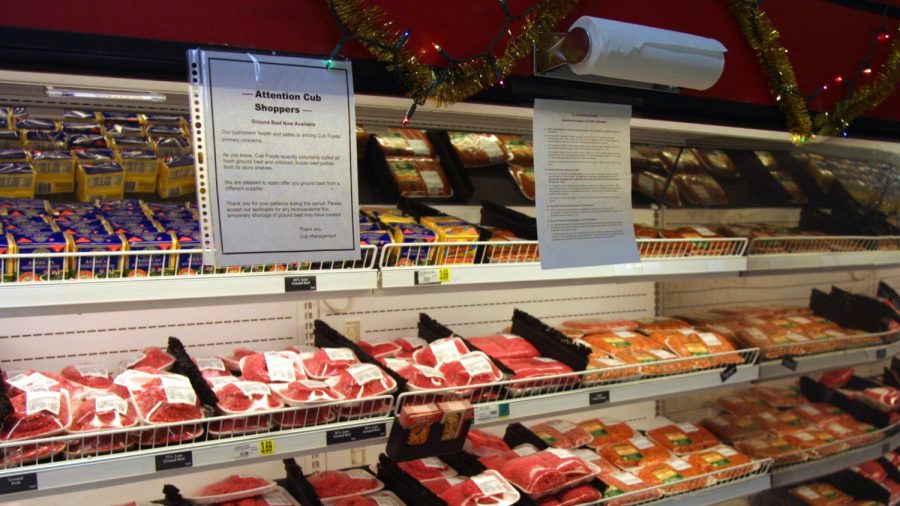Over 100,000 pounds of ground beef has been recalled over possible contamination by E. coli as federal investigators probe an outbreak of the bacteria that has left over 100 people infected.
The beef was produced by Georgia-based K2D Foods under the brand name Colorado Premium Foods, according to the U.S. Department of Agriculture’s Food Safety and Inspection Service.
The service and its partners, including the Centers for Disease Control and Prevention (CDC) and the Tennessee Department of Health, have been investigating an outbreak of a strain of E. coli O103.
A total of 156 people have been infected with the strain. Twenty of those have been hospitalized.

“Preliminary epidemiologic information suggests that ground beef is the source of this outbreak,” the CDC stated in an April 23 alert.
“Ill people in this outbreak report eating ground beef at home and in restaurants. Traceback investigations are ongoing to determine the source of raw ground beef supplied to grocery stores and restaurant locations where ill people reported eating.”
K2D Foods appears to be the first supplier identified in the outbreak, though the Food Safety and Inspection Service noted, “At this time, there is no definitive link between this positive product and the ongoing E. coli O103 outbreak.”
Unopened packages of the company’s beef were collected as part of the ongoing investigation from a restaurant location, where multiple case-patients reported dining, tested positive for E. coli O103.
“Further traceback and product analysis continues to determine if the recalled products are related to the E. coli O103 outbreak,” the service stated.
The O103 strain is among those that are difficult to identify.


“Most people infected with STEC O103 develop diarrhea (often bloody) and vomiting. Some illnesses last longer and can be more severe. Infection is usually diagnosed by testing a stool sample. Vigorous rehydration and other supportive care is the usual treatment; antibiotic treatment is generally not recommended. Most people recover within a week, but, rarely, some develop a more severe infection,” the service stated.
“Hemolytic uremic syndrome (HUS), a type of kidney failure, is uncommon with STEC O103 infection. HUS can occur in people of any age but is most common in children under 5 years old, older adults, and persons with weakened immune systems. It is marked by easy bruising, pallor and decreased urine output. Persons who experience these symptoms should seek emergency medical care immediately,” it added.
The beef may have been consumed by some people at home or in restaurants. The beef was sold to distributors in Florida and Georgia for distribution to restaurants.
They were sold in 24-pound packages in cardboard boxes labeled “Ground Beef Puck.”
The beef was produced on March 26, March 29, April 2, April 5, April 10, and April 12. It had “Use Thru” dates of 4/14/19, 4/17/19, 4/20/19, 4/23/19, 4/28/19, and 4/30/19.
The packages also contained the USDA establishment number “EST. 51308.”
Anyone with the beef was urged to throw it away or return it to the place of purchase.

Recalls
According to a report (pdf) published by the Department of Agriculture’s Economic Research Service published in 2018, there were an average of 304 recalls between 2004 and 2008 and an average of 676 recalls between 2009 and 2013.
The following six food categories accounted for most of the recalls across those years: prepared foods and meals, 11.9 percent; nuts, seeds, and nut products, 10.9 percent; baked goods, 9 percent; grains and grain products, 8.4 percent; candy products, 7.9 percent, and sauces, condiments, and dressings, 5 percent.
The most common reason for each category except for nuts was a failure to declare major allergens. The most common reason for nut recalls was possible salmonella contamination.
Overall, 41 percent of the recalls were the result of pathogen contamination, such as salmonella or E. coli, while 27.4 percent were the result of undeclared allergens.
The most significant recall event between 2004 and 2013 took place in January 2009. Peanut butter linked to a salmonella outbreak was recalled.
The outbreak was ultimately responsible for at least 714 illnesses and nine deaths, and led to the recall of a number of products containing peanut butter or peanut paste, including cookies, crackers, and cereal; overall, over 400 separate recalls related to the outbreak occurred.
Salmonella can cause salmonellosis, a common bacterial foodborne illness, which causes an estimated 1.2 illnesses and 450 deaths in the United States every year, noted the CDC.
Symptoms include diarrhea, abdominal cramps, and fever within 12 to 72 hours after consuming a contaminated product. Most people recover without treatment; most of those hospitalized suffer from severe diarrhea. The illness typically lasts four to seven days.
According to the CDC, roughly 1 in 6 Americans, or 48 million people, get sick every year from foodborne diseases such as salmonella. Of those, approximately 128,000 are hospitalized and 3,000 die.


